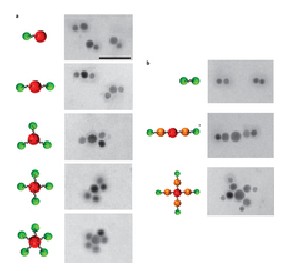Jul
13
Building Structures With Quantum Dots
July 13, 2011 | Leave a Comment
Quantum dots are particles of semiconductor material that can absorb and emit light efficiently. For many looking into the future these really tiny dots of material offer great promise.
University of Toronto (UT) researchers examining the photosynthetic apparatus in plants have been inspired to devise and engineer a new generation of nanomaterials that control and direct the energy absorbed from light. The UT team has built antennas of nanomaterials that control and direct the energy absorbed from light.
UT researchers Professors Shana Kelley and Ted Sargent, report the construction of what they term “artificial molecules” of quantum dots in the journal Nature Nanotechnology.
Kelly explains, “Nanotechnologists have for many years been captivated by quantum dots – particles of semiconductor that can absorb and emit light efficiently, and at custom-chosen wavelengths. What the (research) community has lacked – until now – is a strategy to build higher-order structures, or complexes, out of multiple different types of quantum dots. This discovery fills that gap.” Kelly’s UT credentials are impressive, Professor at the Leslie Dan Faculty of Pharmacy, the Department of Biochemistry in the Faculty of Medicine, and the Department of Chemistry in the Faculty of Arts & Science.
The team Kelly and Sargent are leading has combined its expertise in DNA and in semiconductors to invent a generalized strategy to bind certain classes of nanoparticles to one another.
Sargent, another impressive UT person, occupies the Canada Research Chair in Nanotechnology, is a professor in The Edward S. Rogers Sr. Department of Electrical & Computer Engineering at UT. The team effort is another excellent example of cross-field innovation. Sargent takes up the explanation saying, “The credit for this remarkable result actually goes to DNA: its high degree of specificity – its willingness to bind only to a complementary sequence – enabled us to build rationally-engineered, designer structures out of nanomaterials. The amazing thing is that our antennas built themselves — we coated different classes of nanoparticles with selected sequences of DNA, combined the different families in one beaker, and nature took its course. The result is a beautiful new set of self-assembled materials with exciting properties.”
A conventional antenna ‘increases’ the amount of an electromagnetic wave, such as a radio or TV frequency that is absorbed, and then funnels that energy to a circuit. The UT nanoantennas operate similarly by increasing the amount of light that is absorbed and funneling it to a single site within their molecule-like complexes. This would be an important means to increase the net energy collected.
This concept is already used in nature with light harvesting “antennas” the constituent parts of leaves that make photosynthesis efficient.
Sargent explains, “Like the antennas in radios and mobile phones, our (quantum dot) complexes captured dispersed energy and concentrated it to a desired location. Like the light harvesting antennas in the leaves of a tree, our complexes do so using wavelengths found in sunlight.”
The Dean of the Leslie Dan Faculty of Pharmacy Professor Henry Mann, kicks in justifiably proudly, “Professors Kelley and Sargent have invented a novel class of materials with entirely new properties. Their insight and innovative research demonstrates why the University of Toronto leads in the field of nanotechnology,”
Others might take a little competitive issue with that, but UT is first with an impressive concept in working lab form. The UT press release note a competitors comment that back up the gravity of the threshold the UT team has crossed.
Paul S. Weiss, Fred Kavli Chair in NanoSystems Sciences at UCLA and Director of the California NanoSystems Institute is quoted saying, “This is a terrific piece of work that demonstrates our growing ability to assemble precise structures, to tailor their properties, and to build in the capability to control these properties using external stimuli.”
The story is just getting going. Professor Kelly notes the concept discussed in the published paper goes beyond light antennas alone saying, “What this work shows is that our capacity to manipulate materials at the nanoscale is limited only by human imagination. If semiconductor quantum dots are artificial atoms, then we have rationally synthesized artificial molecules from these versatile building blocks.”
Along with the matters of getting further than the lab to larger scale and understanding what the costs might be there is the directions yet to be followed by other researchers and the innovation and new connections to other technology. Quantum dots are so new, so basic that the potential is still a frontier. But science is now an important step in and that step promotes many, many more going who knows where. This is great news.
Heads up for headhunters, other team members are Sjoerd Hoogland and Armin Fischer of The Edward S. Rogers Sr. Department of Electrical & Computer Engineering, and Grigory Tikhomirov and P. E. Lee of the Leslie Dan Faculty of Pharmacy.


